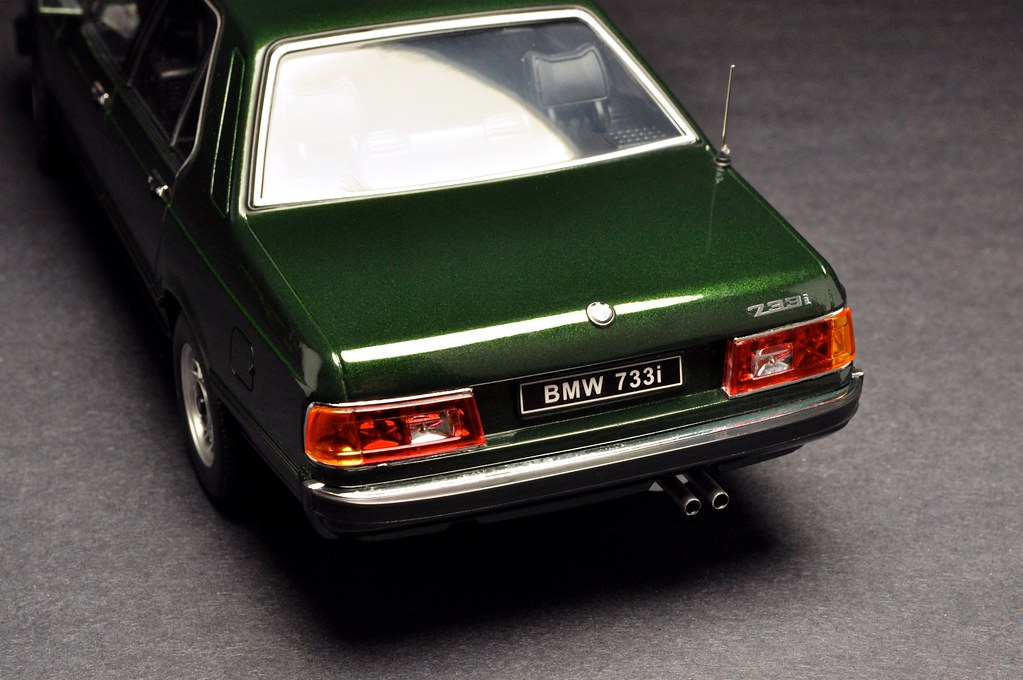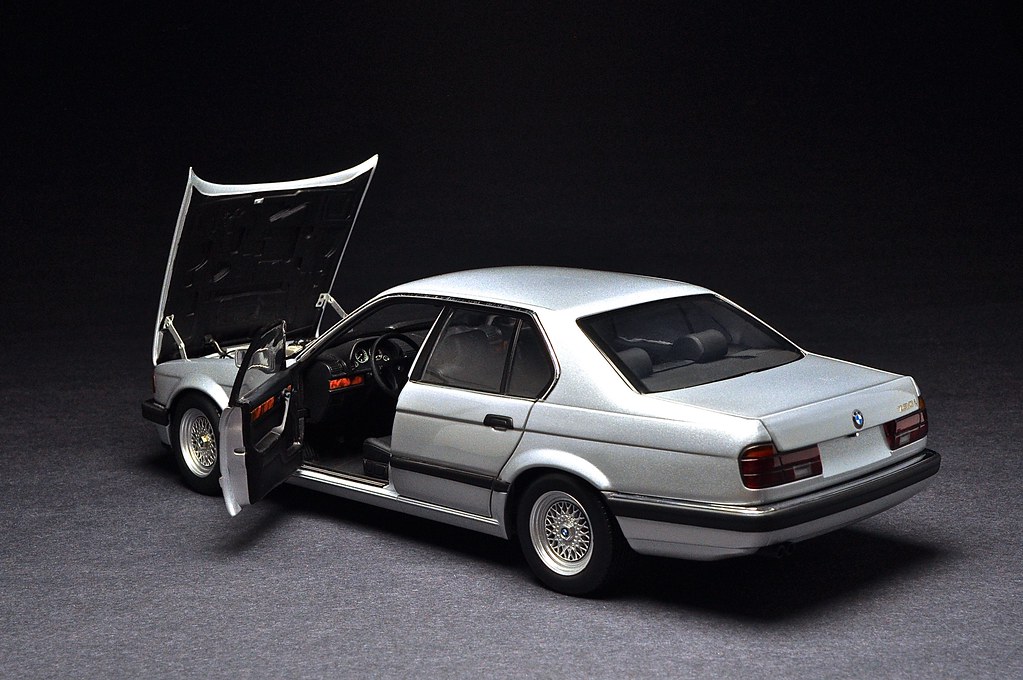#450991 History of BMW in 1:18 Scale. 7-Series. Chapter 1. E23/E32
Previous installments can be found here:
http://scale18.com/cgi-bin/page/msg?func=search&t=history+of+bmw
7-Series
BMW started making 7 series back in 1977, in an attempt to capture the upscale car market occupied at the time by Mercedes Benz and similar big European sedans. While originally a successor to the BMW E3 "New Six" sedan, from the ground-up, 7-series was planned as a flagship car for Bavarian auto maker. Currently in its 6th generation, it is available only in sedan form (both long and short wheelbases), and traditionally is a measuring stick for most BMW innovations and technological advancements, which then trickles down to “lesser” BMW models.
Throughout the generations, Sevens had multiple power plants fitted to them. The first 7 Series was powered by straight-6 gasoline engines, but following models have been equipped with inline-4, straight-6, V8 and V12 engines, both naturally aspirated and turbocharged. Since 1995, diesel engines have been optional in the 7 Series, and a very popular choice for buyers of a power and torque-hungry big sedan.
Unlike 3 and 5 series cars, 7-series was never offered as an M-model (as in M7), but in 2014 BMW officially released a M Performance option for the 7 series, which was very popular. Nowadays BMW 7-series is synonymous with luxury and it is one of the best upscale sedan you can buy. So BMW succeeded in their quest – but it didn’t start that way back in 1977.
E23
First generation of 7 series, code-named E23, was introduced in 1977 and was produced until 1987 – which is a very long time to stay on the production line by modern standards. Penned by brilliant Paul Bracq and Manfred Rennen in 1974, E23 was a beautiful and purposeful sedan. The cars were powered by the classic BMW naturally aspirated straight six engines, but starting in 1983 a supercharged six was available as an option.
E23 introduced a lot of “firsts” for Bavarian company – things such as an onboard computer, service interval indicator, a push-button "check control panel" which would tell the driver about malfunctions, a recording device and complex climate control systems. It was also the first BMW to offer an anti-lock braking system, a driver's airbag and double-link front suspension. All of this set the tone for all future 7-series generations, and has been a trademark for new BMW flagship sedans since.
Up until very recently, there were no scale models of the first generation 7 series made in 1/18 scale. Somewhat surprising, seeing how there are dozens of E24 6-series models made by various manufacturers. That was until in 2016, when Chinese manufacturer KK Scale, a then newcomer to the market, released 3 color versions of the 733i sedan in black, silver, and green metallic.
It was a highly anticipated release in scale BMW collecting world, but the actual release turned out to be a complete disappointment. Not only was the model sealed, it was extremely simplified – to the point that if it wasn’t the only version of E23 in this scale, I would likely not even buy it.


The proportions are mostly correct, though there are a few awkward lines that were not present on the real car. Outside detailing is very average, with most chrome trim painted with silver paint, very simple lights with visible mounting tabs, hard and disproportionate tires, very subpar paint with visible orange peel texture on it, and foggy glass parts. To make matters worse, there was no chassis detail to even speak of, the model was sitting super high and from any angle it just appeared to be off. The price was only $69 but that was hardly a consolation.



About the only thing that was going for the model was the fact the it was available in nice shade of green (and maybe photo-etched badges). The packaging was nice box with Styrofoam clamshell-type insert to hold the model. The rest of the model was bad. But up to this day – this is the only release of E23 in 18th scale. Let’s hope that another manufacturer makes a model that does the first generation 7 series justice at some point.
BMW E23 7-series (1977-1986) 1/18 scale model cars
KK Scale BMW E23 733i Black Metallic, Lim. Ed. 1000 KKDC180101
KK Scale BMW E23 733i Silver, Lim. Ed. 1000 KKDC180102
KK Scale BMW E23 733i Green Metallic, Lim. Ed. 1000 KKDC180103
E32
Designed by Ercole Spada and Hans Kerschbaum under the direction of Claus Luthe, second generation 7-series was stunningly beautiful car, and quite a departure from familiar BMW design language of the 70s. From its introduction in 1986 to the last day of production in 1994 E32 was widely considered one of the most technologically advanced cars in its day and set the standard for performance luxury vehicles well into the 1990s.
Available with inline six, V8, and V12 engines, E32 was revolutionary in every way - some of world's first automotive features for passenger vehicles were introduced in the E32: Electronic Damper Control, Traction Control System, dual-zone climate control, projector lens headlamps, double glazing windows, HID (Xenon) headlamps, to name a few.
Introduction of the first V8 since early 60s 501/2 cars, and first post-war production V12 fitted to a passenger car were hard to ignore, and made Mercedes Benz postpone the release of their W140 by nearly 2 years in an attempt to develop a worthy competitor. E32 became a legend among Bavarian luxury sedans, and is still held in high regard among aficionados of the brand. The car was replaced with the third generation 7-series, codenamed E38 in 1994.
In 1/18 scale, the E32 was made only by Minichamps as a 730i variant, but what an excellent model it is! Full-open, full-detail diecast, with a meticulously replicated engine bay and chassis with functioning suspension, carpeted interior and trunk, multi-piece collapsible hood hinges, and photo-etched badges. At the time of release, it was a glorious diecast model.


The only complaints about the model were poorly executed front headlamps (visible pins holding them in place) and chrome window surround trim, which was done with chrome foil. It looked fine at first, but with time, the glue would weaken on many models making the foil shrink and tear/crinkle a bit.


The model was released in 3 color versions – Sterling Silver, Titan Red, and Black. These were an instant success, and sold out rather quickly (no information available as to how many were made of each color). Few years ago Minichamps announced that they will re-release E32 in two new colors – Ganite Silver and what appears to be an Island Green (judging by the promo photos), but the release has been postponed several times, and at this point it is unclear if this will ever happen. As such, original issues are sold for a considerable premium on auction sites, in some cases reaching $500+ for a mint boxed models.


Excellent interior and engine detail, and just look at this chassis! Fully detailed exhaust, front and rear suspensions, and great undercarriage detail.
To be continued in the next post.












